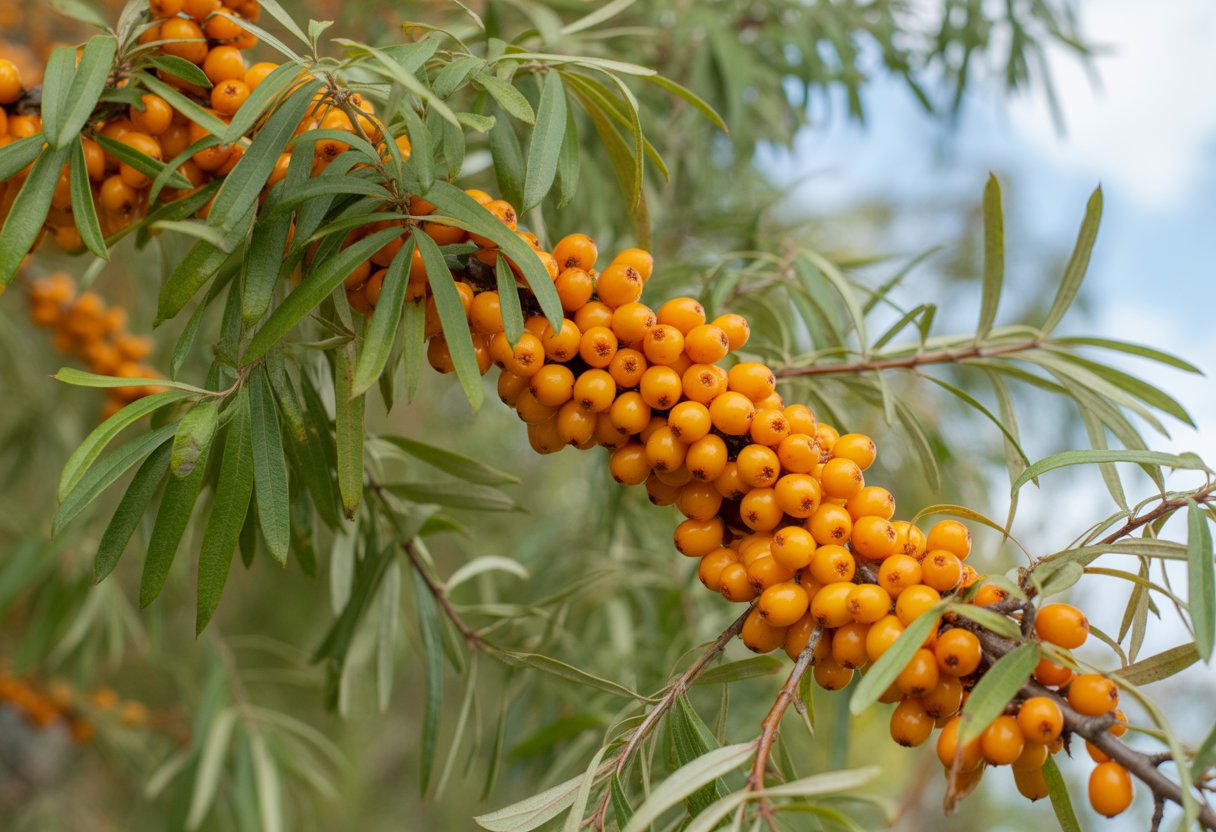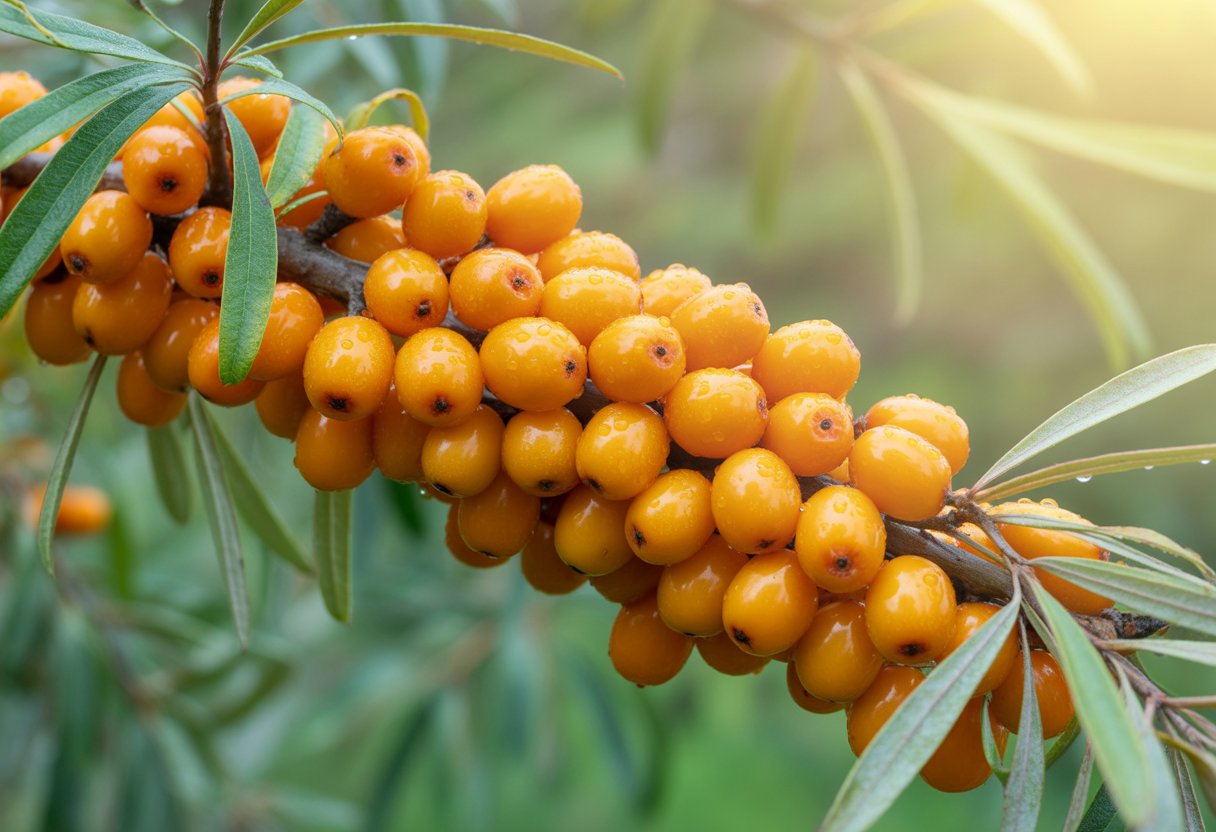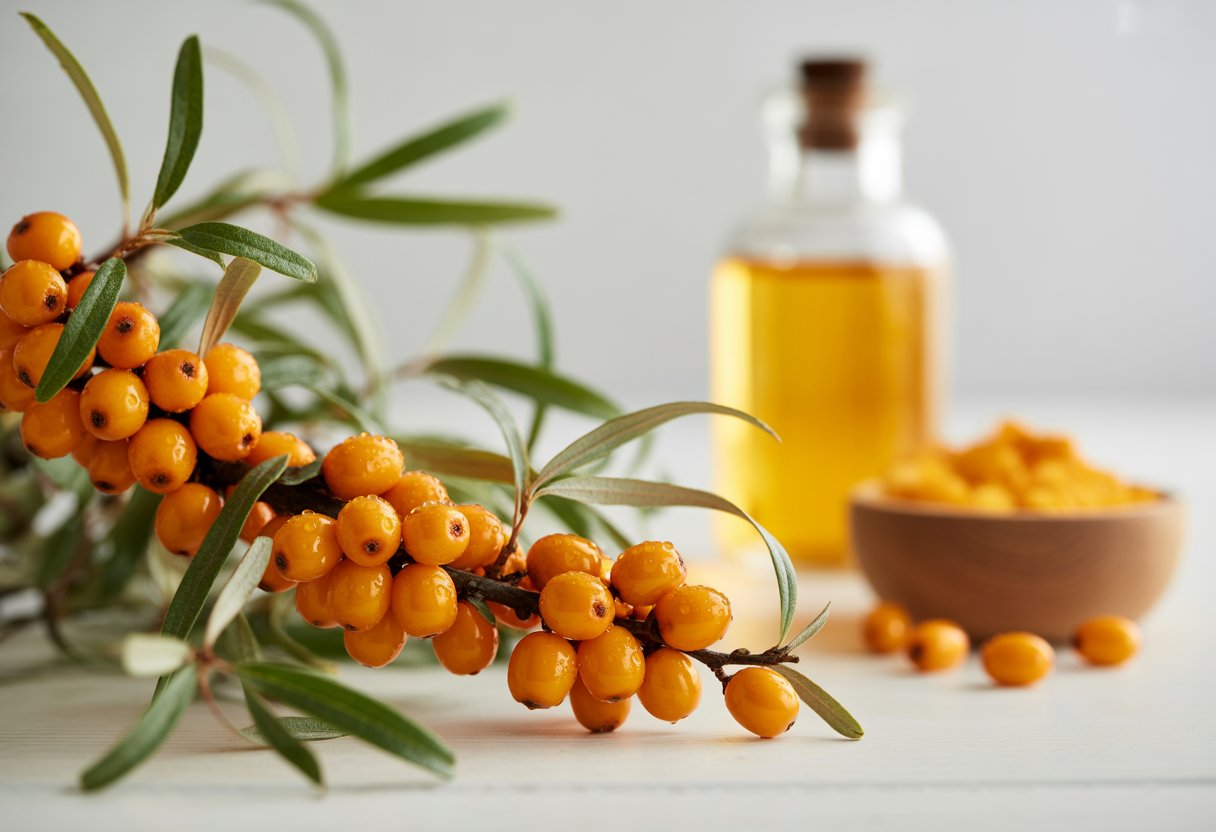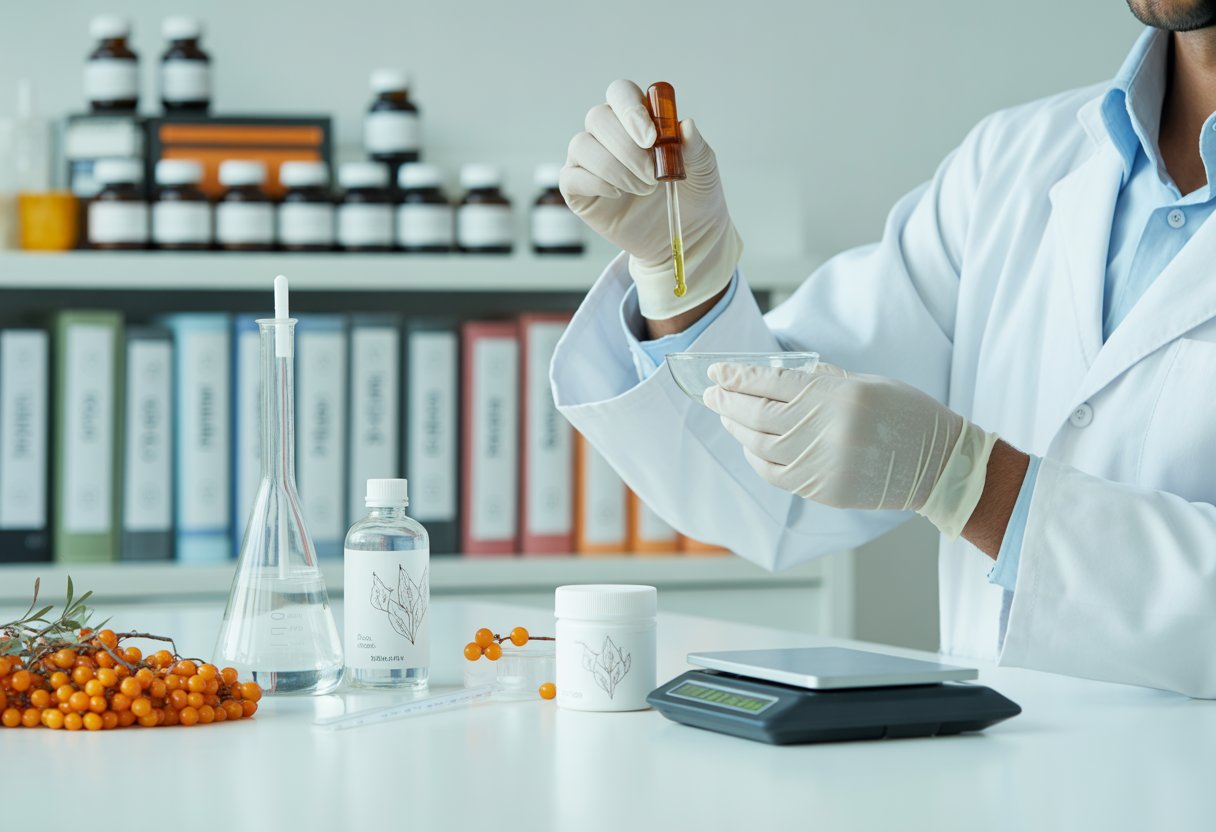Sea buckthorn is a nutrient-dense shrub that produces bright orange berries packed with vitamins, antioxidants, and healthy fats. This hardy plant grows in harsh climates across Asia and Europe, where it has been used for centuries in traditional medicine. Sea buckthorn offers potential benefits for skin health, wound healing, and reducing inflammation[1] while providing high levels of vitamin C, omega fatty acids, and other essential nutrients.

The small orange berries contain more vitamin C than citrus fruits and are rich in vitamins A, E, and K. Sea buckthorn also provides rare omega-7 fatty acids along with antioxidants that may help protect against oxidative stress and support heart health[2]. These compounds work together to give sea buckthorn its unique healing properties.
People use sea buckthorn in many forms, including oils, supplements, juices, and skincare products. Research suggests it may help with various health concerns, from protecting the liver and boosting immunity to improving cardiovascular health[3]. The plant’s versatility and nutrient density make it a popular choice for those seeking natural health solutions.
Key Takeaways
- Sea buckthorn berries contain exceptionally high levels of vitamin C, omega fatty acids, and powerful antioxidants
- The plant shows promise for supporting skin health, wound healing, heart health, and immune function
- Sea buckthorn is available in multiple forms including oils, supplements, and topical products for various health applications
What Is Sea Buckthorn?

Sea buckthorn is a hardy shrub scientifically known as Hippophae rhamnoides[4] that grows across temperate regions of Europe and Asia. This thorny plant produces small orange berries packed with nutrients and has adapted to survive in harsh coastal and mountainous environments.
Botanical Profile and Etymology
Sea buckthorn belongs to the family Elaeagnaceae and is scientifically classified as Hippophae rhamnoides. The plant is a deciduous shrub that typically grows 2 to 4 meters tall.
The shrub features narrow, silvery-green leaves and thorny branches. Female plants produce bright orange berries that cluster densely along the branches. Male and female flowers grow on separate plants, making both necessary for berry production.
The name “sea buckthorn” comes from the plant’s ability to grow near coastlines and its thorn-covered branches. The scientific name Hippophae derives from Greek words meaning “horse” and “shining,” referring to the glossy coat horses developed when fed the leaves.
The berries are small, round, and measure about 6-9 millimeters in diameter. They have a tart, acidic taste and contain a single large seed. The orange color comes from high levels of carotenoids and other antioxidants.
Geographical Distribution and Habitat
Sea buckthorn grows naturally across a vast range spanning Europe and Asia. The plant thrives in temperate climates from sea level to elevations of 4,300 meters.
Primary Growing Regions:
- Northern and Central Europe (Scandinavia, Baltic states, Central Asia)
- Russia and Siberia
- Mongolia and Northern China
- Himalayan regions of Nepal, India, and Pakistan
The shrub prefers well-drained, sandy soils and can tolerate poor soil conditions. It grows along coastlines, riverbanks, and mountain slopes. Sea buckthorn handles extreme temperatures, surviving winter lows of -43°C and summer highs above 40°C.
The plant has excellent salt tolerance, making it valuable for coastal erosion control. Its extensive root system helps stabilize soil and prevents erosion. Sea buckthorn also fixes nitrogen in soil through root nodules, improving soil fertility.
Varieties and Related Species
The genus Hippophae contains seven recognized species, with Hippophae rhamnoides being the most commercially important. Several subspecies and cultivars have been developed for different climates and uses.
Main Hippophae rhamnoides Subspecies:
- H. r. rhamnoides (European coastal variety)
- H. r. mongolica (Central Asian variety)
- H. r. sinensis (Chinese variety)
- H. r. caucasica (Caucasus mountain variety)
Other Hippophae species include H. salicifolia from the Himalayas and H. tibetana from Tibet. These species have smaller berries and different growth patterns compared to H. rhamnoides.
Commercial cultivars have been bred for higher berry yields, improved flavor, and reduced thorniness. Popular varieties include ‘Askola’, ‘Tytti’, and ‘Terhi’ from Finland, and ‘Hergo’ and ‘Leikora’ from Germany.
Female cultivars are typically chosen for berry production, while specific male varieties like ‘Romeo’ and ‘Pollmix’ serve as pollinators. The sea buckthorn benefits[1] vary slightly between varieties based on their nutrient profiles.
Nutritional and Bioactive Compounds

Sea buckthorn berries contain exceptionally high levels of vitamin C, essential fatty acids, and powerful antioxidant compounds. The plant produces over 190 bioactive substances that contribute to its nutritional value.
Vitamins and Minerals
Sea buckthorn berries rank among the richest natural sources of vitamin C on Earth. Fresh berries contain 200-1500 mg of vitamin C per 100 grams. This amount exceeds oranges by 5-10 times.
The berries also provide significant amounts of vitamin E. They contain four forms of vitamin E compounds called tocopherols. These work together to protect cells from damage.
Vitamin K appears in moderate amounts in the berries. This vitamin helps blood clot properly and supports bone health.
The fruit supplies several B vitamins including B1, B2, and B6. These vitamins help the body convert food into energy.
Sea buckthorn contains important minerals like potassium, calcium, and iron. Potassium helps regulate blood pressure. Calcium strengthens bones and teeth. Iron carries oxygen through the blood.
Fatty Acids and Omega Content
Sea buckthorn oil contains a rare balance of omega fatty acids. The berries provide both omega-3 and omega-6 fatty acids in useful amounts.
Omega-7 fatty acids make sea buckthorn special among plants. Most plants do not produce omega-7 fatty acids. The berries contain palmitoleic acid, the main omega-7 fatty acid.
The seeds contain different fatty acids than the pulp. Seed oil has more omega-3 and omega-6 fatty acids. Pulp oil contains more omega-7 and omega-9 fatty acids.
These fatty acids support heart health and reduce inflammation. They also help maintain healthy skin and mucous membranes throughout the body.
Flavonoids and Polyphenols
Sea buckthorn contains over 60 different flavonoids. These compounds give the berries their bright orange color and bitter taste.
Quercetin ranks as one of the most abundant flavonoids in the berries. This compound has strong anti-inflammatory effects. It also helps protect blood vessels from damage.
Rutin appears in high concentrations in sea buckthorn leaves and berries. Rutin strengthens blood vessel walls and reduces swelling.
The berries contain phenolic acids like caffeic acid and ferulic acid. These compounds work with flavonoids to provide health benefits.
All these polyphenols work together as a team. They protect the plant from environmental stress and provide benefits to people who consume them.
Antioxidant Properties
Sea buckthorn demonstrates exceptionally high antioxidant activity in laboratory tests. The berries score higher than many other fruits on standard antioxidant measures.
The combination of vitamin C, vitamin E, and polyphenols creates powerful antioxidant effects. These compounds neutralize harmful free radicals that can damage cells.
Carotenoids like beta-carotene add to the antioxidant power. These orange pigments protect against oxidative stress and support eye health.
The antioxidant properties remain stable even after processing. Dried berries and oils maintain much of their protective activity for months when stored properly.
Health Benefits of Sea Buckthorn

Sea buckthorn offers powerful antioxidant protection and essential fatty acids that support multiple body systems. The plant’s berries, leaves, and oil provide vitamins, minerals, and bioactive compounds that may help fight cancerous cells and reduce inflammation[3].
Skin Health and Wound Healing
Sea buckthorn oil contains high levels of vitamin E, vitamin C, and omega fatty acids that nourish skin cells. These nutrients help repair damaged tissue and maintain healthy skin barrier function.
The oil’s anti-inflammatory properties make it useful for treating various skin conditions. Studies show that sea buckthorn benefits include potential treatment for conditions like eczema[1] and other inflammatory skin disorders.
Key compounds for skin health:
- Omega-7 palmitoleic acid
- Vitamin E (tocopherols)
- Carotenoids (beta-carotene)
- Vitamin C
Research indicates that sea buckthorn enhances wound healing[3] by promoting cell regeneration. The plant’s nutrients speed up the formation of new tissue and reduce healing time.
Topical applications of sea buckthorn oil help moisturize dry skin. The oil penetrates deeply into skin layers without leaving a greasy residue.
Anti-Inflammatory Effects
Sea buckthorn contains powerful antioxidants that combat oxidative stress throughout the body. These compounds neutralize free radicals that cause cellular damage and chronic inflammation.
The plant’s flavonoids and phenolic acids work together to reduce inflammatory markers. This action helps protect tissues from damage caused by ongoing inflammation.
Anti-inflammatory compounds include:
- Quercetin
- Isorhamnetin
- Kaempferol
- Anthocyanins
Sea buckthorn may help reduce inflammation[2] in joints and muscles. This makes it potentially beneficial for people with arthritis or other inflammatory conditions.
Regular consumption of sea buckthorn products may lower levels of inflammatory proteins in the blood. This systemic effect supports overall health and reduces disease risk.
Cardiovascular Health
Sea buckthorn supports heart health, including prevention and treatment of cardiovascular diseases[5], through multiple mechanisms. The plant’s omega fatty acids help maintain healthy cholesterol levels and improve blood vessel function.
Studies suggest that sea buckthorn improves cardiovascular health[3] by reducing risk factors for heart disease. These include high blood pressure, elevated cholesterol, and arterial inflammation.
The antioxidants in sea buckthorn protect blood vessels from oxidative damage. This protection helps maintain flexible arteries and proper blood flow.
Cardiovascular benefits:
- Lower LDL (bad) cholesterol
- Reduced blood pressure
- Improved circulation
- Decreased arterial inflammation
Sea buckthorn oil contains palmitoleic acid, an omega-7 fatty acid that supports healthy blood lipid profiles. This nutrient is less common in other plant sources.
Regular intake may help prevent the formation of arterial plaques. This protective effect reduces the risk of heart attacks and strokes.
Digestive and Gut Health
Sea buckthorn supports digestive system function through its anti-inflammatory and healing properties. The plant’s nutrients help maintain the integrity of the intestinal lining.
Traditional medicine has long used sea buckthorn leaves and flowers for treating gastrointestinal ulcers[6] and other digestive issues. Modern research supports these traditional uses.
The plant’s compounds may help reduce stomach acid production while promoting healing of damaged tissue. This dual action benefits people with ulcers or acid reflux.
Digestive system support:
- Reduced stomach inflammation
- Faster ulcer healing
- Improved gut barrier function
- Better nutrient absorption
Sea buckthorn oil helps protect the stomach lining from damage caused by medications or stress. The oil forms a protective barrier while supplying healing nutrients.
The plant’s fiber content supports healthy gut bacteria when consumed as whole berries or juice. This prebiotic effect improves overall digestive health.
Metabolic and Disease-Related Applications

Sea buckthorn shows promise in managing blood sugar levels, supporting weight management, and protecting against serious diseases like cancer and liver cirrhosis. Research indicates its bioactive compounds may help regulate metabolism and reduce disease risk factors, including metabolic syndrome[7].
Blood Sugar Regulation and Insulin Response
Sea buckthorn berries contain compounds that may help control blood sugar levels. Studies show the fruit’s antioxidants can improve how cells respond to insulin.
The omega-7 fatty acids in sea buckthorn oil appear to enhance insulin sensitivity. This means cells can use glucose more effectively after meals.
Research indicates that regular consumption may reduce post-meal blood sugar spikes. The polyphenols in the berries slow down sugar absorption in the intestines.
Key blood sugar benefits:
- Improved insulin response
- Reduced glucose spikes
- Better cellular glucose uptake
- Enhanced metabolic function
Some studies suggest sea buckthorn extract may help people with pre-diabetes. However, more human trials are needed to confirm these effects.
Weight Loss Potential
Sea buckthorn oil contains omega-7 palmitoleic acid, which may support weight management. This fatty acid appears to signal the body to stop storing excess fat.
Animal studies show sea buckthorn extract can reduce belly fat accumulation. The compounds may boost metabolism and increase fat burning.
The berries are naturally low in calories but high in nutrients. This makes them useful for people trying to lose weight while maintaining good nutrition.
Weight management properties:
- Metabolic boost: Increases energy expenditure
- Fat reduction: Targets abdominal fat storage
- Appetite control: May help reduce food cravings
- Nutrient density: Provides vitamins with few calories
Human studies on weight loss remain limited. Most evidence comes from animal research and small preliminary trials.
Cancer Research and Protective Effects
Sea buckthorn contains multiple compounds that show antitumor effects[8] in laboratory studies. The high levels of antioxidants may help protect cells from damage that leads to cancer.
Laboratory research shows sea buckthorn extracts can slow the growth of certain cancer cells. The flavonoids and carotenoids appear to have the strongest protective effects.
Some studies suggest the berries may help reduce inflammation linked to cancer development. The vitamin C content is particularly high, supporting immune system function.
Anti-cancer compounds:
- Flavonoids
- Carotenoids
- Vitamin C and E
- Polyphenolic acids
Most cancer research involves cell cultures or animal models. Clinical trials in humans are still needed to prove effectiveness.
Liver Health and Cirrhosis
Sea buckthorn leaves show hepatoprotective actions[8] that may help protect liver function. The compounds appear to reduce liver inflammation and scarring.
Studies indicate sea buckthorn extract can help regenerate damaged liver tissue. This is particularly important for people with fatty liver disease or cirrhosis.
The antioxidants in sea buckthorn may prevent further liver damage from toxins. Research shows improved liver enzyme levels in some studies.
Liver protection mechanisms:
- Reduces inflammation
- Prevents scarring (fibrosis)
- Supports tissue regeneration
- Protects against toxins
People with severe liver disease should consult doctors before using sea buckthorn supplements. The research is promising but still developing.
Common Uses and Product Forms

Sea buckthorn is available in multiple forms including oils, juices, powders, capsules, and topical products. Each form offers different concentrations of nutrients and suits specific health or beauty applications.
Sea Buckthorn Oil Varieties
Sea buckthorn oil comes in two main types based on extraction source. Seed oil contains high levels of omega-3 and omega-6 fatty acids. Berry oil provides omega-7 fatty acids and carotenoids.
Cold-pressed extraction methods preserve the most nutrients. Heat processing can reduce vitamin content but often costs less. Some manufacturers blend seed and berry oils for balanced nutrition profiles.
Key Oil Characteristics:
- Seed Oil: Light yellow color, nutty flavor
- Berry Oil: Deep orange-red color, fruity taste
- Blended: Combines benefits of both varieties
Most sea buckthorn oils appear to promote wound healing[1] when applied topically. Quality varies between brands based on extraction methods and storage conditions.
Juice and Powder
Sea buckthorn juice retains water-soluble vitamins and antioxidants from fresh berries. Pure juice tastes tart and acidic. Many products blend it with sweeter fruits like apple or pear.
Commercial juices often contain added sugars or preservatives. Organic options typically have fewer additives. Fresh juice provides the highest nutrient density but spoils quickly.
Sea buckthorn powder comes from freeze-dried or spray-dried berries. Powder form allows longer storage and easy mixing into smoothies or recipes. It concentrates nutrients but may lose some heat-sensitive vitamins during processing.
Powder Applications:
- Smoothie additions
- Baking ingredients
- Hot beverage mixes
Dietary Supplements and Functional Foods
Capsules and tablets offer standardized doses of sea buckthorn extract. Clinical trials use dosages ranging from 500 milligrams to 1,500mg per day[1] for various health applications.
Soft gel capsules typically contain sea buckthorn oil. Hard capsules may include powdered berry extract or concentrated nutrients. Some products combine sea buckthorn with other herbs or vitamins.
Functional foods incorporate sea buckthorn into everyday items. These include energy bars, yogurts, and breakfast cereals. The berry adds nutritional value and natural orange coloring to processed foods.
Common Supplement Forms:
- Oil-filled soft gels
- Extract capsules
- Chewable tablets
- Liquid concentrates
Cosmetic and Topical Applications
Sea buckthorn appears in many skincare products due to its fatty acid content. Face creams, serums, and moisturizers use the oil for its potential anti-aging properties. The antioxidants may help protect skin from environmental damage.
Hair care products include sea buckthorn for scalp nourishment. Shampoos and conditioners claim to strengthen hair follicles and add shine. Some treatments target hair loss concerns.
Body lotions and balms use sea buckthorn oil for dry skin relief. The oil absorbs well without leaving greasy residue. Many products combine it with other plant oils like jojoba or argan.
Popular Cosmetic Products:
- Anti-aging serums
- Moisturizing creams
- Hair growth treatments
- Lip balms
- Body oils
Quality varies significantly between cosmetic brands. Higher concentrations of sea buckthorn oil typically cost more but may provide better results.
Safety, Dosage, and Regulations

Sea buckthorn dosages vary widely based on the specific health condition being addressed, ranging from 1-45 grams daily in clinical studies. The supplement carries minimal documented side effects, though excessive consumption can cause skin discoloration.
Recommended Dosage and Administration
Clinical trials have used dosages[9] ranging from 5 to 45 grams of freeze-dried sea buckthorn berries, puree, and seed or pulp oil. Traditional healers recommend approximately 20 grams per day of fruit.
Condition-Specific Dosing:
- Dry eye symptoms: 1 gram twice daily for 3 months
- Cardiovascular health: 300 mL of juice over 8 weeks
- Skin conditions: 5 grams daily of seed or pulp oil for 4 months
- Liver support: 15 grams three times daily of extract for 6 months
Sea buckthorn juice has been administered safely in volumes up to 300 mL daily over 8-week periods. For antimicrobial benefits, studies used 28 grams daily for 90 days.
The wide dosage range reflects different forms of the supplement. Oil extracts typically require smaller amounts than whole berry preparations.
Potential Side Effects and Risks
Sea buckthorn demonstrates excellent safety profiles in most users. No well-documented contraindications[9] exist for the supplement.
The primary side effect is carotenodermia. This condition causes yellow to orange skin discoloration from excessive carotenoid accumulation. The discoloration is completely harmless and reversible.
Safety Considerations:
- Pregnant and breastfeeding women should avoid use
- No documented drug interactions
- No toxicology data available
The skin discoloration occurs only with very high consumption levels. Most users taking recommended dosages experience no adverse effects.
People with sensitive skin may notice mild digestive upset when first starting supplementation. This typically resolves within a few days of continued use.
FDA and NSF Oversight
The FDA regulates sea buckthorn as a dietary supplement, not as a prescription medication. This means manufacturers cannot make specific disease treatment claims without approval.
Dietary supplements fall under different regulatory standards than pharmaceutical drugs. The FDA does not test supplements for safety or effectiveness before they reach market shelves.
Regulatory Status:
- Classified as dietary supplement
- No FDA pre-market approval required
- Manufacturers responsible for safety testing
- Limited quality control oversight
NSF International provides voluntary third-party testing for supplement quality and purity. Consumers should look for NSF certification when choosing sea buckthorn products.
The supplement industry relies heavily on self-regulation. Reputable manufacturers conduct their own safety and quality testing to ensure product consistency.
Frequently Asked Questions

Sea buckthorn offers numerous health benefits through its high vitamin C content and omega fatty acids. The plant serves multiple purposes from dietary supplements to skincare applications and can be grown in harsh climates.
What are the health benefits of sea buckthorn?
Sea buckthorn berries contain exceptionally high levels of vitamin C, often exceeding oranges by 10 times or more. This vitamin supports immune system function and helps the body absorb iron from food sources.
The berries provide omega-3, omega-6, and omega-9 fatty acids. These nutrients support heart health and may help reduce inflammation in the body.
Sea buckthorn contains antioxidants including flavonoids and carotenoids. These compounds help protect cells from damage caused by free radicals.
The plant also provides vitamin E, vitamin A, and B-complex vitamins. These nutrients support skin health, eye function, and energy metabolism.
Can sea buckthorn juice provide any specific nutritional advantages?
Sea buckthorn juice delivers concentrated amounts of the plant’s key nutrients in liquid form. One serving typically provides several times the daily recommended amount of vitamin C.
The juice contains natural sugars that provide quick energy. It also includes amino acids that support protein synthesis in the body.
Fresh sea buckthorn juice retains most of the berry’s water-soluble vitamins. However, processing methods can affect the final nutrient content.
The juice has a tart, acidic taste that many people find strong. Some manufacturers blend it with other fruit juices to improve palatability.
What are the uses of sea buckthorn oil in skincare?
Sea buckthorn seed oil contains high concentrations of omega-3 and omega-6 fatty acids. These nutrients help maintain skin barrier function and moisture retention.
The oil from the berry pulp provides omega-7 fatty acids and carotenoids. These compounds give the oil its characteristic orange color and may support skin repair processes.
People apply sea buckthorn oil directly to dry or irritated skin. The oil absorbs relatively quickly without leaving a heavy residue.
Some skincare products include sea buckthorn oil as an active ingredient. These products range from facial serums to body lotions and lip balms.
How might sea buckthorn supplements support overall wellness?
Sea buckthorn supplements typically come in capsule, powder, or liquid extract forms. These products concentrate the plant’s nutrients into convenient daily doses.
The supplements may help people who struggle to get enough vitamin C from their regular diet. They also provide omega fatty acids for those who don’t consume fish or nuts regularly.
Some research suggests sea buckthorn supplements may support digestive health. However, more studies are needed to confirm these potential benefits.
People should consult healthcare providers before starting any new supplement regimen. Sea buckthorn can interact with certain medications or cause digestive upset in sensitive individuals.
In what ways can sea buckthorn be incorporated into a daily diet?
Fresh sea buckthorn berries can be eaten raw, though their tartness may be intense for some people. They work well mixed into yogurt, smoothies, or oatmeal.
The berries make excellent jams, jellies, and sauces when cooked with sweeteners. These preparations help balance the natural sourness while preserving many nutrients.
Sea buckthorn juice blends well with other fruit juices or sparkling water. Many people dilute it due to its strong flavor and high acidity.
Dried sea buckthorn berries can be added to trail mixes, granola, or baked goods. The drying process concentrates the flavors and extends shelf life significantly.
What should be considered when cultivating sea buckthorn plants?
Sea buckthorn thrives in poor soils and tolerates coastal winds and cold climates[10]. The plants actually prefer sandy or rocky soil conditions over rich, fertile ground.
These shrubs require both male and female plants to produce berries. Growers typically plant one male plant for every six to eight female plants to ensure proper pollination.
Sea buckthorn plants develop extensive root systems that help prevent soil erosion. However, these roots can spread aggressively and may require management in small gardens.
The plants begin producing berries after three to four years of growth. Mature shrubs can yield 20 to 30 pounds of berries annually under good growing conditions.
Harvesting requires careful timing since the berries ripen all at once in late summer. The thorny branches make hand-picking challenging, so many growers use specialized equipment.
References
- potential benefits for skin health, wound healing, and reducing inflammation. https://www.verywellhealth.com/the-benefits-of-sea-buckthorn-89947 Accessed November 7, 2025
- 12 Health Benefits of Sea Buckthorn + Side Effects. https://supplements.selfdecode.com/blog/sea-buckthorn-benefits/ Accessed November 7, 2025
- 11 Amazing Health Benefits of Sea Buckthorn. https://naturalfoodseries.com/11-benefits-sea-buckthorn/ Accessed November 7, 2025
- From Desert Greening to Human Health: A Systematic Review of the Extraction, Unique Structure, and Bioactivity of Sea Buckthorn Proanthocyanidins. https://www.mdpi.com/2304-8158/14/18/3203 Accessed November 7, 2025
- Research progress of sea buckthorn (Hippophae rhamnoides L.) in prevention and treatment of cardiovascular disease. https://pubmed.ncbi.nlm.nih.gov/39494241/ Accessed November 7, 2025
- Sea Buckthorn: Health Benefits, Side Effects, Uses, Dose & Precautions. https://www.rxlist.com/supplements/sea_buckthorn.htm Accessed November 7, 2025
- Bioactive Compounds in Sea Buckthorn and their Efficacy in Preventing and Treating Metabolic Syndrome. https://www.mdpi.com/2304-8158/12/10/1985 Accessed November 7, 2025
- Research Progress on the Bioactive Components, Health Effects and Functional Food Applications of Sea Buckthorn. https://www.sciopen.com/article/10.26599/FSHW.2025.9250696 Accessed November 7, 2025
- Sea Buckthorn Uses, Benefits & Dosage. https://www.drugs.com/npp/sea-buckthorn.html Accessed November 7, 2025
- Just a moment.... https://www.gardenia.net/plant/hippophae-rhamnoides-sea-buckthorn-grow-care-guide Accessed November 7, 2025
